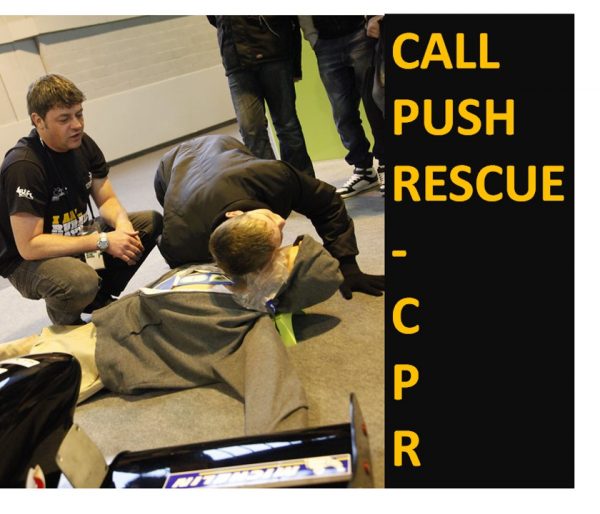
Call Push Rescue CPR
Call Push Rescue CPR :Cardiopulmonary resuscitation or CPR procedure can help to save a life during a breathing or cardiac problem or emergency. Nearly 400,000 deaths happen outside the hospital due to cardiac arrest in Unites States alone. This includes not getting immediate CPR when needed. Understanding what CPR and how to perform CPR is a special skill. Many undergo CPR training, however often they forget what are the steps involved in CPR. And, most of us don’t know how to perform CPR. If somebody undergoes cardiac emergency, instead of stepping into help or take care of the situation we become helpless. This is alarming, as most of the cardiac or heart attack incidents happens at home. This is where CPR comes to rescue. If we know the steps of CPR we can perform it on the person and rescue the life.
Before Giving CPR
- Look at the scene, surrounding and the person who needs CPR. If the scene is safe, tap the person on the shoulder and then shout loudly “Are you OK?” to ensure that the person needs help.
- Call emergency assistance number. If you feel the person needs assistance call the emergency number immediately.
- Open the airway – with the person lying on back tilt the head back slightly to lift the chin.
- Check for breathing – listen carefully for less than 10 seconds for breathing sound. When the airway is open and clear, check for normal breathing:
- Look and feel for movement of the lower chest and upper abdomen.
- Listen and feel for air coming from the patient’s mouth or nose.
- Feel for movement of the lower chest and abdomen and for the escape of air from the patient’s mouth or nose.
- Check for normal breathing but ignore occasional gasps which are inadequate to maintain life.
If the patient is breathing, move them and support them on their side with their head tilted back and continually monitor their breathing.
If the person is not breathing normally, then proceed with CPR
CPR steps
- Push hard, push fast. Place your hands, one on top of the other, in the middle of the chest. Use your body weight to help you administer compressions that are at least 2 inches deep and delivered at a rate of at least 100 compressions per minute. Follow the steps as below;
- Place the heel of ONE HAND in the center of the chest.
- Keep your elbow locked and lean over the patient so your arms are straight.
- Push down hard and fast 30 times (push down one-third of chest depth).
- If you find pushing the chest difficult with one hand, place your other hand on top and continue compressions as for an adult.
- Deliver rescue breaths. With the person’s head tilted back slightly and the chin lifted, pinch the nose shut and place your mouth over the person’s mouth to make a complete seal. Blow into the person’s mouth to make the chest rise. Deliver two rescue breaths, then continue compressions.
*Note: If the chest does not rise with the initial rescue breath, re-tilt the head before delivering the second breath. If the chest doesn’t rise with the second breath, the person may be choking. After each subsequent set of 100 chest compressions, and before attempting breaths, look for an object and, if seen, remove it.
- Continue CPR steps. Keep performing cycles of chest compressions and breathing until the person exhibits signs of life, such as breathing, an AED becomes available, or EMS or a trained medical responder arrives on scene.
CPR for children
Children over one year old
- Open the child’s airway by placing one hand on the child’s forehead and gently tilting their head back and lifting the chin. Remove any visible obstructions from the mouth and nose.
- Pinch their nose. Seal your mouth over their mouth and blow steadily and firmly into their mouth, checking that their chest rises. Give five initial rescue breaths.
- Place the heel of one hand on the centre of their chest and push down by 5cm (about two inches), which is approximately one-third of the chest diameter. The quality (depth) of chest compressions is very important. Use two hands if you can’t achieve a depth of 5cm using one hand.
- After every 30 chest compressions at a rate of 100 to 120 per minute, give two breaths.
- Continue with cycles of 30 chest compressions and two rescue breaths until they begin to recover or emergency help arrives.
Infants under one year old
- Open the infant’s airway by placing one hand on their forehead and gently tilting the head back and lifting the chin. Remove any visible obstructions from the mouth and nose.
- Place your mouth over the mouth and nose of the infant and blow steadily and firmly into their mouth, checking that their chest rises. Give five initial rescue breaths.
- Place two fingers in the middle of the chest and push down by 4cm (about 1.5 inches), which is approximately one-third of the chest diameter. The quality (depth) of chest compressions is very important. Use the heel of one hand if you can’t achieve a depth of 4cm using the tips of two fingers.
- After 30 chest compressions at a rate of 100 to 120 per minute, give two rescue breaths.
- Continue with cycles of 30 chest compressions and two rescue breaths until they begin to recover or emergency help arrives.
Remember – compressing the chest is the most important part of CPR. CPR alone will not be able to start the heart function. However, it restores the partial flow of oxygenated blood to both heart and brain. It avoids the tissue death and brain damage. The most common injury that can happen while doing CPR is rib fracture.
Watch this video to understand how to perform CPR
https://www.youtube.com/watch?time_continue=1&v=9t5MLAB-HZQ
References:
- http://www.nhs.uk
- American Red Cross
- British Heart Association
- American Heart Association
Image credit: “The Skills Show 2012 – Day 1 General” by WorldSkills UK is licensed under CC BY 2.0
Author: HealthyLife | Posted on: September 14, 2017
« Healthy eating tip: Set yourself up for success General tips for skin health »






















Write a comment